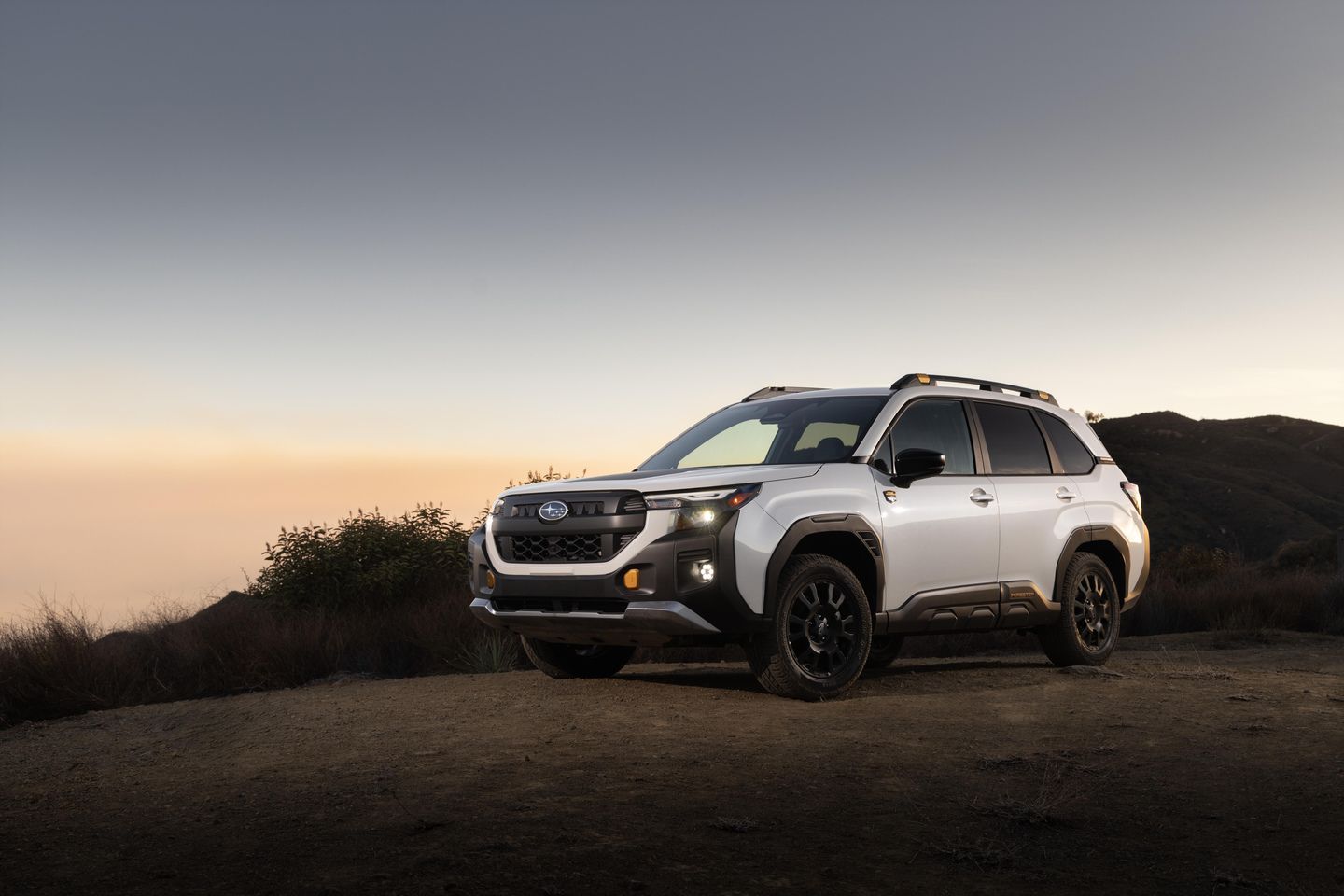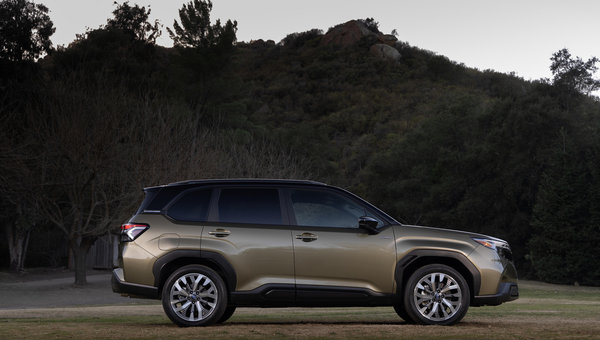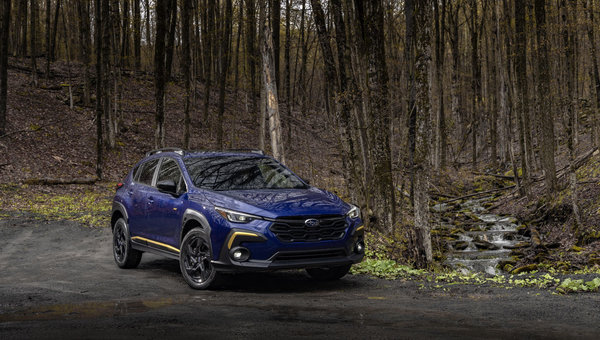Subaru Crosstrek Wilderness vs. Forester Wilderness: Which Off-Road SUV Matches Your Ontario Adventures?
September 24 2025,

Subaru offers two Wilderness editions for Ontario outdoor enthusiasts: the Crosstrek Wilderness and the Forester Wilderness. Both vehicles share Wilderness DNA—235 millimetres of ground clearance, all-terrain tires, dual-function X-MODE, and water-resistant interior materials—but serve different priorities based on trail type and cargo needs.
Choosing between these adventure-ready SUVs depends on your typical activities and passenger requirements. The Crosstrek Wilderness offers nimble handling for tight trails and significant towing capability. The Forester Wilderness provides more interior space for extended trips and larger groups. Understanding their differences helps you match the right vehicle to your outdoor lifestyle.
At a Glance: Wilderness Comparison
|
Feature |
Crosstrek Wilderness |
Forester Wilderness |
|---|---|---|
|
Ground Clearance |
235 mm |
235 mm |
|
Engine |
2.5L (182 hp) |
2.5L (180 hp) |
|
Cargo Capacity (seats up) |
566 L |
762 L |
|
Cargo Capacity (seats folded) |
1,555 L |
1,957 L |
|
Towing Capacity |
1,588 kg (3,500 lbs) |
680 kg (1,500 lbs) |
|
Exterior Length |
4,500 mm |
4,645 mm |
Ground Clearance and Trail Capability
Both Wilderness editions provide identical 235 millimetres of ground clearance, allowing them to clear obstacles that stop regular crossovers. This extra height handles deep ruts on Algonquin backcountry roads, rocky sections on Bruce Trail access routes, or snow-covered winter trails in Kawartha Highlands.
The Crosstrek's compact dimensions create tighter approach and departure angles despite matching ground clearance. On technical trails with steep transitions—forest service roads with drainage ditches or rocky creek crossings—the shorter wheelbase prevents the bumpers from dragging where longer vehicles scrape.
The Forester's additional 145 millimetres of overall length affects maneuverability on narrow trails but provides more interior volume. Both vehicles clear the same obstacles vertically; the Crosstrek navigates tighter spaces more easily while the Forester carries more gear comfortably.
Cargo Space for Different Adventures
The Forester Wilderness offers significantly more cargo capacity: 762 litres with rear seats up compared to the Crosstrek's 566 litres. This 196-litre advantage accommodates bulkier items like large coolers, multiple tents, or full-size camping chairs without folding seats.
With rear seats folded, the Forester provides 1,957 litres versus the Crosstrek's 1,555 litres—a 402-litre difference. For extended camping trips with two adults requiring sleeping bags, cooking equipment, food supplies, and outdoor gear, the Forester's extra space reduces packing compromises.
The Crosstrek's 1,555 litres still handles typical weekend camping gear efficiently for two people. The shorter load distance makes reaching items easier, and the compact footprint improves parking at popular trailheads where space fills quickly on summer weekends.
Cargo Comparison by Activity:
- Canoe camping (3 days, 2 people): Forester's 762 L with seats up holds paddles, personal bags, and cooler while maintaining passenger space
- Mountain biking day trip (4 people): Crosstrek's 566 L with seats up fits helmets, tools, and small packs; bikes mount on roof rack
- Winter camping (2 people, cold-weather gear): Forester's 1,957 L with seats down accommodates bulky sleeping bags, winter clothing, and extra supplies
- Backcountry fishing weekend: Crosstrek's 1,555 L with seats down handles rods, tackle, waders, tent, and supplies for two
All-Terrain Tires and Suspension
Both Wilderness editions ride on all-terrain tires designed for varied surface conditions. These tires provide aggressive tread patterns that improve traction on loose gravel, mud, sand, or snow while maintaining acceptable on-road manners for daily driving.
The Crosstrek Wilderness uses 17-inch black painted wheels that resist scratches from trail debris. The Forester Wilderness features similar 17-inch wheels with rugged all-terrain tires. Both wheel and tire combinations balance ground clearance, sidewall protection, and ride quality.
All-terrain tires create more road noise than highway tires—a trade-off for improved off-road capability. The tread pattern that grips loose surfaces generates more sound on pavement. Both Wilderness models use sound deadening materials to minimize this effect in the cabin, though some additional noise remains noticeable compared to standard models.
Dual-Function X-MODE Performance
Both Wilderness editions include dual-function X-MODE with two settings optimized for different terrain. Snow/Dirt mode handles packed snow, gravel roads, or moderate off-pavement situations. Deep Snow/Mud mode provides maximum traction in challenging conditions—deep snow drifts, muddy spring trails, or sandy beach access roads.
X-MODE integrates control of the engine, transmission, AWD system, and brakes to optimize traction. When activated, the system automatically adjusts these components based on wheel speed sensors and traction availability at each wheel. The driver selects the appropriate mode for conditions, and X-MODE manages the technical details.
Hill Descent Control activates with X-MODE, automatically maintaining constant speed when descending steep grades. The system manages brake pressure at each wheel independently while you focus on steering. This feature proves valuable on steep, loose descents where maintaining slow speeds manually causes brake fade or wheel lockup.
Towing Capacity Differences

The Crosstrek Wilderness handles 1,588 kg (3,500 lbs) when properly equipped—enough for small travel trailers, utility trailers loaded with ATVs, or aluminum fishing boats. This capability opens opportunities for extended off-grid adventures with mobile base camps or transporting recreational equipment.
The Forester Wilderness tows 680 kg (1,500 lbs), suitable for small utility trailers, bike trailers, or lightweight camping trailers. While significantly less than the Crosstrek's capacity, this still accommodates many recreational towing needs without requiring separate tow vehicles for basic hauling tasks.
Towing capacity differences stem from chassis engineering and drivetrain specifications. The Crosstrek's revised transmission includes a CVT oil cooler that improves towing capability and heat management under sustained loads. Consider your typical towing needs carefully when choosing between these models—the difference matters significantly for trailer camping or boat launching.
Interior Design and Materials
Both Wilderness editions feature all-weather soft-touch upholstery designed for active lifestyles. These animal-free materials resist water, making cleanup easier after trail rides, beach trips, or muddy hiking excursions. Simple wiping removes most dirt and moisture without specialized cleaners.
All-weather rubber floor mats come standard on both models, protecting carpet from mud, snow, and spills. The mats feature raised edges that contain liquids and debris, preventing damage to underlying carpet. Remove them periodically for hose-off cleaning between adventures.
The Crosstrek Wilderness interior includes yellow accent stitching and anodized copper trim pieces that create distinctive visual identity. The Forester Wilderness features similar adventure-focused styling cues with Wilderness branding on headrests and exclusive gauge cluster designs that emphasize the off-road capability.
Fuel Economy Considerations
The Crosstrek Wilderness with 2.5-litre engine and CVT oil cooler achieves 9.4 L/100 km city, 8.1 L/100 km highway. The additional ground clearance and all-terrain tires create more aerodynamic drag than standard models, affecting highway efficiency particularly.
The Forester Wilderness delivers fuel economy appropriate for its larger size and capability. Both vehicles accept regular unleaded gasoline, reducing operating costs compared to vehicles requiring premium fuel. The slightly better efficiency of the Crosstrek helps offset its smaller fuel tank capacity during extended backcountry trips.
All-terrain tires and lifted suspension reduce efficiency compared to standard models on highway driving. In off-road conditions where you need their capabilities, the fuel economy difference becomes less relevant—reaching your destination safely matters more than optimal efficiency numbers.
Maneuverability and Parking
The Crosstrek's compact 4,500 millimetre length makes parking at popular trailheads significantly easier. On summer weekends at Frontenac Provincial Park or Kawartha Highlands Provincial Park, finding parking space for larger vehicles becomes challenging. The Crosstrek fits into spots the Forester can't access.
The tighter turning circle helps on narrow forest service roads with limited space for K-turns. When navigating tight switchbacks or backing out of dead-end trails, the Crosstrek's shorter wheelbase provides more flexibility. This agility matters most on technical trails where vehicle placement affects success.
The Forester's additional length provides stability at highway speeds and more interior volume but requires more space for maneuvering. On open trails and wider forest roads, this difference becomes negligible. On tight, technical sections, the Crosstrek's compact dimensions provide clear advantages.
Which Wilderness Matches Your Adventures?
Choose Crosstrek Wilderness if you:
- Navigate tight, technical trails regularly (Frontenac Provincial Park, Kawartha Highlands backcountry)
- Prefer nimble handling and easier parking at popular trailheads
- Need significant towing capability for travel trailers, boat trailers, or utility trailers
- Typically adventure with one or two people
- Want maximum off-road agility in a compact package
- Frequently face tight forest service roads or challenging switchbacks
Choose Forester Wilderness if you:
- Carry more passengers or bulky cargo on adventures
- Prefer spacious interior for extended camping trips (3+ days)
- Need maximum cargo volume for gear-intensive activities (winter camping, extended canoe trips, photography equipment)
- Want easier rear-seat access for passengers or dogs
- Value interior space and cargo flexibility over maximum agility
- Regularly transport families or groups requiring back-seat comfort
Shared Wilderness Capabilities
Both models include:
- 235 millimetres ground clearance for obstacle clearance
- All-terrain tires for varied surface traction
- Dual-function X-MODE with Snow/Dirt and Deep Snow/Mud modes
- Hill Descent Control for controlled steep descents
- Water-resistant all-weather upholstery
- Symmetrical Full-Time All-Wheel Drive
- EyeSight Driver Assist Technology
- Standard roof rails for additional cargo capacity
- All-weather rubber floor mats
Both Wilderness editions provide genuine off-road capability that exceeds typical crossover SUVs. The choice between them depends on your specific needs: maximum cargo and passenger space, or maximum towing and trail agility. Neither compromises Subaru's core strengths—both maintain the reliability, safety, and all-weather capability Ontario drivers depend on year-round.
Discover which Wilderness edition matches your Ontario adventure style—visit Subaru of Maple in Vaughan to compare both models side-by-side and discuss your typical trail conditions with our team.


